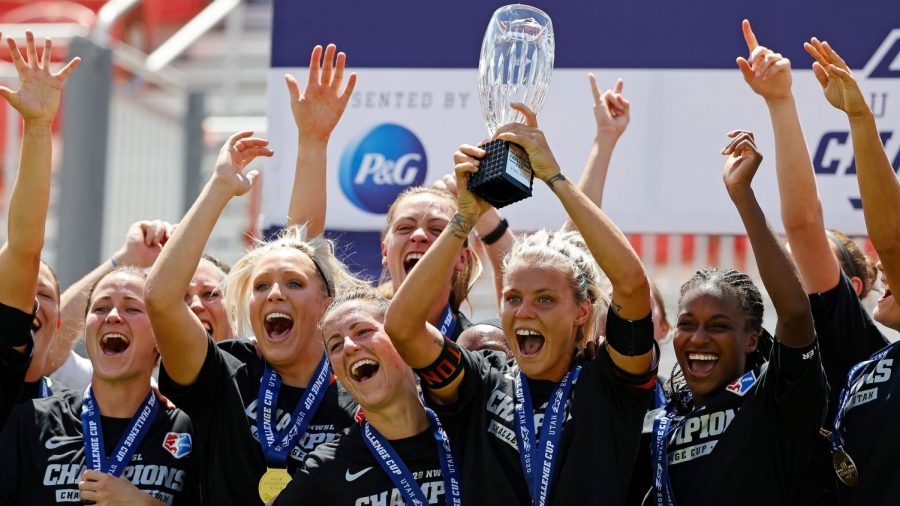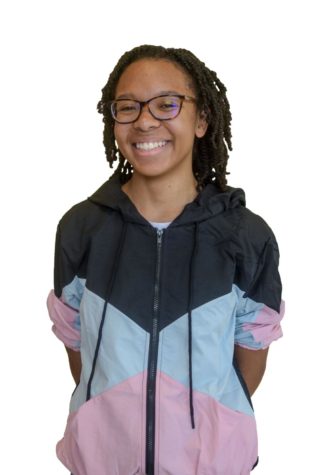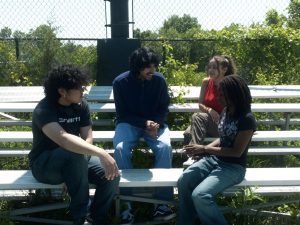NWSL Proves That Sports During COVID-19 Can Be Safe
The Houston Dash celebrate winning the NWSL Challenge Cup
August 23, 2020
Earlier this summer, after months of very little live entertainment, American professional sports leagues began returning to play with varying levels of success. The revival of live sports was spearheaded by the National Women’s Soccer League which recently completed its inaugural tournament, The NWSL Challenge Cup, with record-setting viewership and, even more impressively, no positive coronavirus cases throughout its entirety.
The NWSL announced the month-long tournament on May 27th, after having cancelled their full 2020 season two months prior due to government regulations on group gatherings. During this time, NWSL Commissioner Lisa Baird worked with club owners and the league’s Player Association to weigh options and determine how best to facilitate a return to play given the circumstances. According to Baird, in a May 28th question-and-answer session, the first thing she did was put together “a medical task force of 15 physicians to create the necessary protocols” and ensure the safety of everyone involved. The league’s emphasis on safety, league-wide communication, and player security ultimately led to the tournament being a success on all fronts.
The path from plan to implementation wasn’t without obstacles, and the uncertainty regarding the pandemic made a lot of fans doubt whether or not the NWSL, a league that had faced many organizational challenges in the past, could even pull it off. Critics pointed to the COVID-19 case count in Utah, the state where the tournament was being held, which had been relatively low compared to other states but began rising in June, just before the teams were set to fly in. The viability of the tournament was called into question even more when, just 72 hours before they were set to board their plane to Utah, six players on the Orlando Pride and four of their staff members tested positive for the virus. In a statement the next day, the club officially withdrew from the cup entirely, giving the NWSL mere days to redo the entire tournament schedule. Despite these hiccups, however, the league expressed no intention to cancel or postpone the tournament.
As planned, the cup was held in Zions Bank Stadium in Herriman Utah, and later, Rio Tinto Stadium in Sandy, Utah, from June 27th to July 26th, and it occurred behind closed doors with no fans permitted in the stadiums. A week before it began, players and staff from eight of the NWSL’s nine teams flew to Utah where they were required to quarantine in the “NWSL Village,” a collection of hotels and athletic centers near the stadiums, for the entirety of their teams’ tenure in the tournament. This “bubble” format allowed the league to control as much of the environment as possible, and the extensive safety protocols included daily temperature screenings and frequent testing for everyone involved.
Not only did the league prioritize the health of the players, but also the economic security. For most of the NWSL players, playing is their only source of income. Through negotiations with the league, The NWSL Player Association ensured that all players that chose to opt out would still be paid their full base salary and they negotiated accommodations for mothers to bring their children and spouses into the bubble. Nearly all of the league’s players chose to play in the tournament, with a few big names like Carli Lloyd, Megan Rapinoe, and Tobin Heath choosing to opt out citing health concerns or injury.
Regarding the gameplay, the format of the Challenge Cup was noticeably different than that of a normal season. Typically, each of the 9 teams plays 24 games each, with the top 4 seeds moving onto the semifinals. But with the new shortened format, each team played 4 preliminary round games, with every team advancing to the quarter-finals and then from there having 4 rounds of single-elimination knockout games to determine a champion.
The NWSL would not have had the financial backing necessary to execute this tournament if it weren’t for its new sponsors: Procter & Gamble (and it’s Secret brand), Google, and Verizon. The monetary investment from these companies made up for the lack of revenue gained from physical ticket sales which are typically the league’s primary source of income. Additionally, right before the regular 2020 season was cancelled, the NWSL worked out a three-year deal with CBS and Twitch to make games more accessible for national and international viewers. This deal enabled the NWSL to have their games shown to a much broader audience, allowing them to break their league’s viewing records. The final game of the tournament, between the Houston Dash and the Chicago Red Stars, aired on CBS and garnered 653,000 views, a more than 240% increase from their previous record of 190,000 views. It’s certainly impressive that the league’s been able to continue their upward momentum even in the face of its many pandemic-related obstacles.
The NWSL’s smaller size no doubt made this process easier to manage. Some larger leagues have since begun their process of returning to play and are running into a variety of challenges. The MLB, who refused to implement a bubble format, has already seen several virus outbreaks in teams across the league which, to date, has led to 30 games getting postponed. One team, the Miami Marlins, had 18 players test positive, and they’re not even a month into the season. Major League Soccer (MLS) also had to postpone games after five players on their Nashville team tested positive. Other leagues, on the other hand, have seen promising results so far. The NBA had a couple breaches in their bubble, but was able to isolate and quarantine sick players before re-entering them into the mix. The WNBA and NHL have exercised similar cautions and, though they’ve had players test positive right before their seasons began, they haven’t seen any outbreaks since. The NWSL has so far been the only league to finish their season with zero cases and have set the example for what a successful return to play can and should look like. Every league is different, but when safety, organization, and communication are at the forefront, the case number can be minimized.














































Mr. Ellis • Sep 29, 2020 at 7:31 PM
I think you make a compelling case Alana…well written piece for sure. Definitely feeling for all of our student athletes right now,, and can’t wait to see them back in action Thanks for bringing an informed perspective on an issue a lot of us are thinking about right now.
-Mr. Ellis